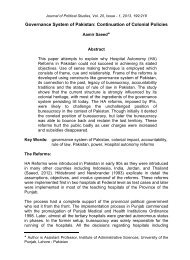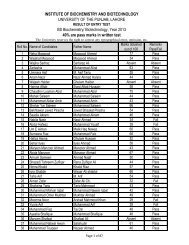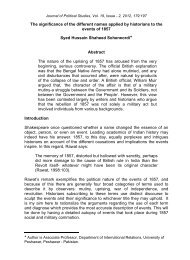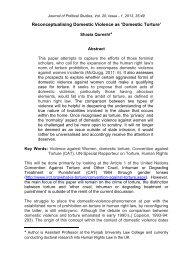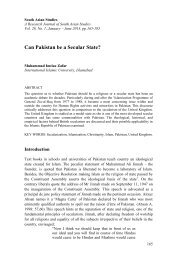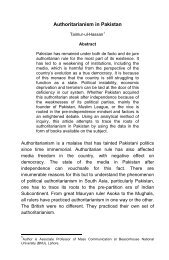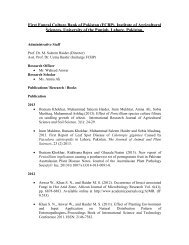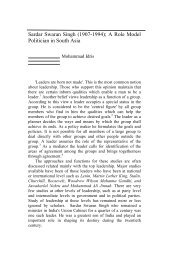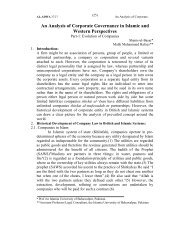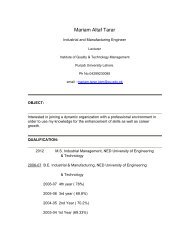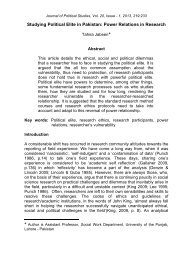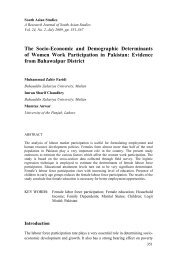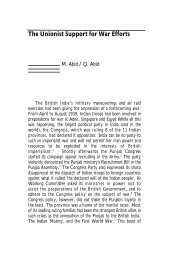pakistan geographical review 1954 - University of the Punjab
pakistan geographical review 1954 - University of the Punjab
pakistan geographical review 1954 - University of the Punjab
You also want an ePaper? Increase the reach of your titles
YUMPU automatically turns print PDFs into web optimized ePapers that Google loves.
dry. RailfaH at Sukkur is less than 4"; and <strong>the</strong> temperatures are high.<br />
AI.though <strong>the</strong> air is very-dry and hot in summer yet it is not so distressing as<br />
elsewhere in <strong>the</strong> north. The nights are generally cooler. The climate almost<br />
resembles that <strong>of</strong> <strong>the</strong> semi-desert type. During summer dust storms are very<br />
common every evening.<br />
The wea<strong>the</strong>r condit i-ins during December, January and February are<br />
typically cold and bracing. From April to June, and some times in July, hot<br />
dry winds blow from <strong>the</strong> North-east and South-east. During May and June,<br />
<strong>the</strong> scorching heat <strong>of</strong> <strong>the</strong> sun and wind is intolerable. The temperature in <strong>the</strong><br />
shade goes upto 112°F. The humidity mounts to 80 p.c. Dampness makes <strong>the</strong><br />
climate sticky and disagreeable.<br />
In this irrigated tract <strong>the</strong> town <strong>of</strong> Sukkur is subject to much water<br />
logging which results in mosquito breeding. For this reason malaria is <strong>the</strong> main<br />
disease affecting <strong>the</strong> population during <strong>the</strong> winter season. During June, July,<br />
August, and September high humidity, ~sanitary conditions <strong>of</strong> <strong>the</strong> larger<br />
part <strong>of</strong> <strong>the</strong> town and <strong>the</strong> unsatisfactory diets <strong>of</strong> <strong>the</strong> major section <strong>of</strong> <strong>the</strong><br />
population <strong>of</strong>ten result in <strong>the</strong> outbreak <strong>of</strong> cholera, small pox and diarrhoea in<br />
<strong>the</strong> town. The outbreak <strong>of</strong> such an epidemic is always local and always starts<br />
from <strong>the</strong> section <strong>of</strong> <strong>the</strong> town where <strong>the</strong> poor or working class population is<br />
housed. The majority <strong>of</strong> <strong>the</strong> cases are always in those localities which may<br />
be called <strong>the</strong> slums <strong>of</strong> <strong>the</strong> town. The dirt and <strong>the</strong> refuse <strong>of</strong> <strong>the</strong> houses<br />
contaminate <strong>the</strong> atmosphere and are mainly responsible for <strong>the</strong> spread <strong>of</strong> such<br />
diseases in <strong>the</strong> town. For <strong>the</strong> above reason <strong>the</strong> epidemic germs breed in<br />
abundance and make <strong>the</strong> winter and rainy season generally unhealthy.<br />
The natural vegetation <strong>of</strong> Sind, as a whole, is very poor and <strong>the</strong> greater<br />
part <strong>of</strong> <strong>the</strong> region has herbaceous vegetation; along <strong>the</strong> banks <strong>of</strong> <strong>the</strong> river<br />
Indus thickets <strong>of</strong> shrubs and a few trees <strong>of</strong> arid and semi-arid or tropical type<br />
are found. In <strong>the</strong> rainless, arid and hot tract <strong>of</strong> <strong>the</strong> Sukkur area, due to <strong>the</strong><br />
loamy nature <strong>of</strong> <strong>the</strong> soil and <strong>the</strong> quantity <strong>of</strong> fresh water available, babul<br />
(Acacia arabica) shishum (dalborgia) bhan or white poplar, tammarind as well<br />
as grasses <strong>of</strong> various descriptions grow well. A mixed forest belt spreads over<br />
a narrow strip <strong>of</strong> land, 25 X 2 miles, all along <strong>the</strong> banks <strong>of</strong> <strong>the</strong> Indus from <strong>the</strong><br />
towns <strong>of</strong> Ghotki and Shikarpur upto Sukkur and even fur<strong>the</strong>r below. This belt<br />
is <strong>of</strong> riverain forests which depend upon <strong>the</strong> flood water <strong>of</strong> <strong>the</strong> river for <strong>the</strong>ir<br />
growth. The total forest stratches over about 5 sq. miles <strong>of</strong> land in <strong>the</strong> Sukkur<br />
area <strong>of</strong> which 80% is riverain and 20% inland forests. According to <strong>the</strong><br />
5}



